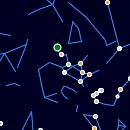Comet 90004853 C/2024 J3 (ATLAS) Observation Details
/90004853 C/2024 J3 (ATLAS).png)
C/2024 J3 (ATLAS) Daily Motion
C/2024 J3 (ATLAS) will reach its transit before twilight, at 16:10. By the onset of twilight at 17:59, it will be at elevation, and it will set before sunrise, at 21:37.90004853 C/2024 J3 (ATLAS) will be visible until November, 18, when it will move too close to the Sun. During this time, its proximity to the Sun will cause it to disappear from the night sky, making it unobservable for a while.
C/2024 J3 (ATLAS) Visibility Timetable on October 14
C/2024 J3 (ATLAS) Rise and Set Timetable
| Time | Elevation | |
| Moon Set | 13:26 | 29° |
| C/2024 J3 (ATLAS) transit | 16:10 | 42° |
| Sunset | 16:31 | 42° |
| Civil sunset | 16:59 | 41° |
| Astrosession begin | 17:59 | 36° |
| C/2024 J3 (ATLAS) set | 21:37 | |
| Moon Rise, 44.2% illuminated | 22:18 | -8° |
| Astrosession end | 03:48 | -63° |
| C/2024 J3 (ATLAS) rise | 10:40 |
Track C/2024 J3 (ATLAS) Position Throughout the Night
← Tue, 14 October 2025 →
| Time | |
| Altitude | |
| Azimuth |
Shift the map to change the time and observe C/2024 J3 (ATLAS) changing position in the night sky.
C/2024 J3 (ATLAS) Description
C/2024 J3 (ATLAS), designated as 90004853 C/2024 J3 (ATLAS), is a comet on a hyperbolic (unbound) trajectory. At the moment, 90004853 C/2024 J3 (ATLAS) is 5.306 AU (793,811,181 km) from Earth, and it is located in the constellation Scutum.Current position of C/2024 J3 (ATLAS) in Solar System
| Date | Tue, 14 October 2025 |
| Distance from Earth to C/2024 J3 (ATLAS) | 5.3063 AU (793,811,181km) |
| Elongation | 78° |
| Angular diameter | " |
| Magnitude | 16.1 |
Finder Chart for C/2024 J3 (ATLAS)
Double-click to unlock the map.
| Object name | 90004853 C/2024 J3 (ATLAS) |
| Field of view | |
| Limiting magnitude | |
| 90004853 C/2024 J3 (ATLAS) coordinates | 18.56876, -10.48311 |
| Center coordinates | 18.56876, -10.48311 |
Annual motion of C/2024 J3 (ATLAS)
| Date | Wed, 15 October 2025 |
| Twighlight start | 17:57 |
| Twighlight end | 03:46 |
| Twighlight duration | 10h 49m |
| Rise | 10:40 |
| Set | 21:33 |
| Elevation at transit | 42° |
| Transit time | 16:06 |
| Equatorial coordinates | RA: 18h 34m 19s", Dec: -10° 25' 23s |
| Magnitude | 16 |
| Constellation | Scutum |
The graph illustrates the annual visibility pattern of a C/2024 J3 (ATLAS), providing a comprehensive overview of its daily appearances and transit times throughout the year.
The graph is structured with the vertical axis showing the hours of the day, ranging from 12 AM to 12 AM the next day, while the horizontal axis spans each day of the year.
The reddish shaded area indicates the periods when the C/2024 J3 (ATLAS) is above the horizon, visible to observers. The white line marks the times when the celestial object reaches its highest point in the sky each day, known as the transit.
The graph is structured with the vertical axis showing the hours of the day, ranging from 12 AM to 12 AM the next day, while the horizontal axis spans each day of the year.
The reddish shaded area indicates the periods when the C/2024 J3 (ATLAS) is above the horizon, visible to observers. The white line marks the times when the celestial object reaches its highest point in the sky each day, known as the transit.
Astrometric & Physical Parameters of 90004853 C/2024 J3 (ATLAS)
Coordinates & Visibility
| Right Ascension | 18.56876° |
| Declination | -10.48311° |
| Magnitude | 16.1 |
| Constellation | Scutum |
| Elevation | 31.9° |
| Azimuth | 138.2° |
Acknowledgments
We acknowledge NASA's Jet Propulsion Laboratory (JPL) for providing essential data on asteroids and comets through their Small-Body Database (SBDB) and Center for Near-Earth Object Studies (CNEOS). Their continuous efforts in tracking and cataloging these celestial bodies make it possible to offer accurate and up-to-date information on their positions, orbits, and physical characteristics.
